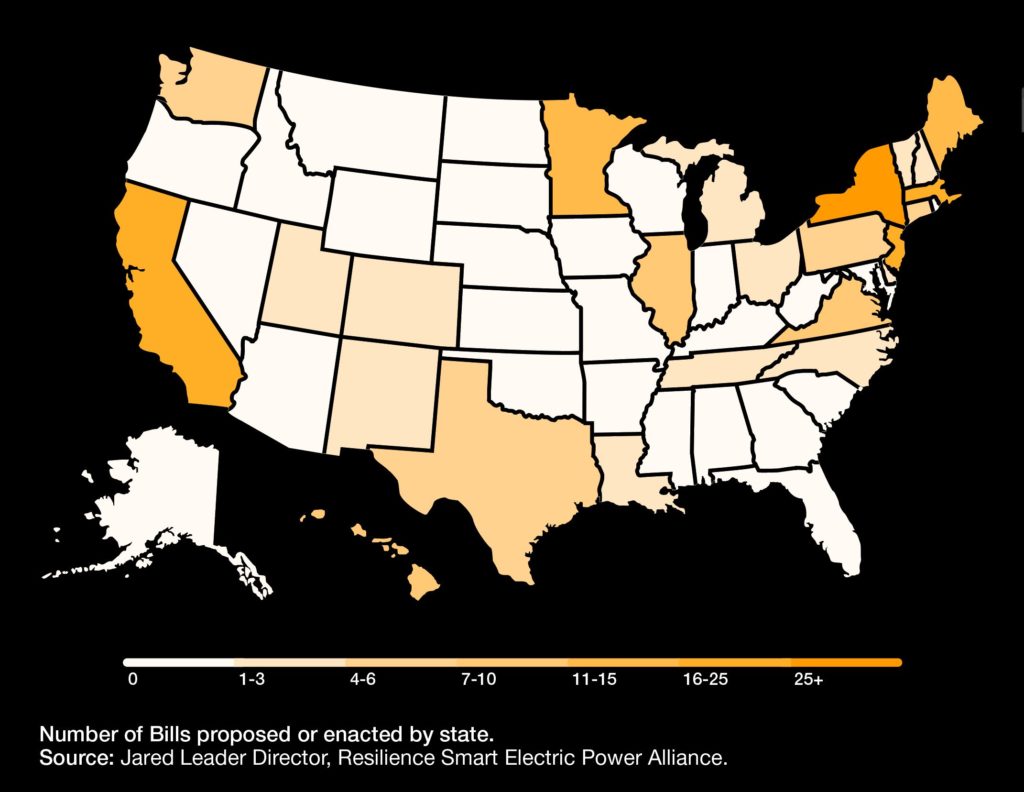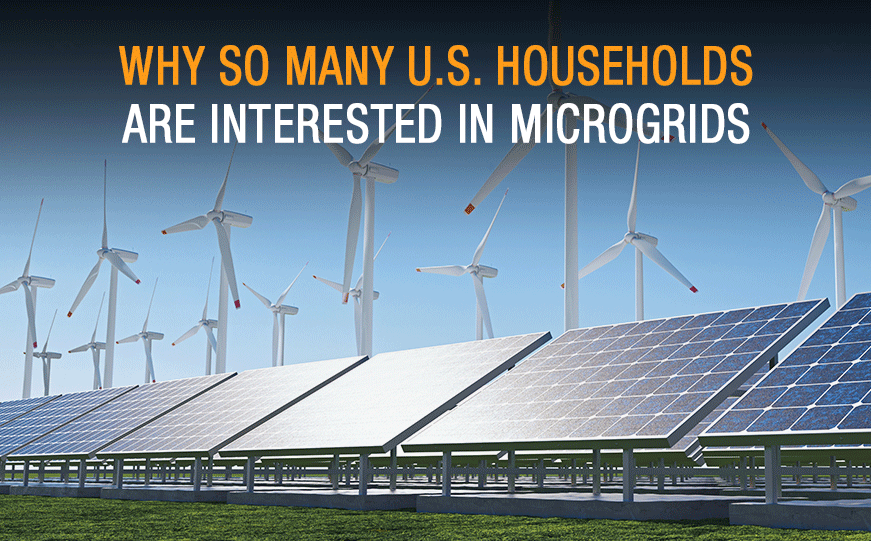Steve Kleber, founder of integrated marketing communications firm Kleber & Associates, and I recently discussed the growing momentum — and opportunities — for microgrids and how they will impact the building industry.
~ Chris Luzar, Frohman & Associates
More U.S. households are interested in solar than ever before.
Why? It’s no surprise that reducing costs on electric bills and a desire to “go green” are the top two motivators. Of course, the 30 percent federal tax credit included in the Inflation Reduction Act (IRA) — is also a definite accelerator.
The impact of multiple incentives drives breakthrough results:
- Residential solar power installations rose by 34 percent from 2.9 GWh in 2020 to 3.9 GWh in 2021.
- Residential solar set its fifth consecutive quarterly growth record in Q2, 2022.
- Solar in the U.S. is forecasted to triple in five years.
It’s clear that rooftop solar is a solid growth story. But it’s not the whole story.
The brutal lesson learned, is that during severe weather events — including wildfires, hurricanes or weather-related outages — rooftop solar will not keep the lights on when the grid fails.
After all, most rooftop solar installations function through a grid connection… rather than battery storage and advanced inverters. So, when the grid goes down, rooftop solar panels lose their voltage source. Rapid shutdown — a requirement of the National Electrical Code — is designed to protect crews working on downed lines.
In contrast, “microgrids” rely on their own energy resources to operate during a grid shutdown. Intelligent software controls sense the pending voltage disruption. And, accordingly, can automatically decouple a structure from the grid. Microgrid customers maintain power, even when those around them are in the dark.
Microgrids are not new
Microgrids traditionally have been installed “100 percent off-grid” to provide constant, reliable power to isolated outposts… islands, military installations, mining sites, or insular ranches located “at the end of the transmission line.” In remote locations, solar PV microgrids are the cleaner and cheaper alternative to diesel power plants.
Yet, amid worsening climate patterns during the past 10 years, the appeal of microgrids has grown significantly — together with technological advances — including solar PV systems, battery storage and fuel cells.
The Smart Electric Power Alliancen (SEPA) reports that in the six-year timeframe from 2015-2021 there were 184 bills focused on microgrid legislative action proposed or enacted across 24 states and D.C.

SEPA identified three overarching objectives of microgrid legislation:
- Secure funding for new/enhanced microgrid development
- Increase pressure to invest in state climate goals
- Prioritize microgrid support for disadvantaged communities.
Today, traditional microgrids still operate, but the application of microgrids has expanded. The data are compiled by the DOE and published in their Microgrid Installation Database.
It’s clear: as climate change and storms may intensify… microgrids are becoming more viable, to provide community energy resilience.
Industry experts promote the following approaches to accelerate microgrid growth.
Innovative Ownership and Operational Business Models
To minimize upfront capital investment and risk, industry experts often recommend outsourcing via models such as “EaaS” (Energy as a Service) or “RaaS” (Resiliency as a Service).
EaaS /RaaS provide the engineering, permitting, construction and system maintenance over the term of a contract. Organizations pay for the engineering design and deployment service, operational support and energy consumed.
Modular System Development
The design principle for microgrids historically has been 100 percent customization… as each microgrid is uniquely configured to meet specific application needs. Intense customization is a big advantage, yet the absence of a modular design also introduces significant deployment and operational costs.
Guidehouse Insights, provider of market intelligence for emerging technology sectors, identifies North America as the market leader for modular microgrids with a projected 23.2 percent compounded annual growth rate for new capacity by 2029. The modular microgrid market is anticipated to grow to more than $5 billion in annual implementation spending by 2029.
Stakeholder Collaborations: Developer, Utility, Regulator and Consumer
Cuyahoga County Electric Utility Cuyahoga County is the geographic and economic core of the Greater Cleveland Metropolitan Area with more than 1.2 million residents. In September 2021, the County Council established a County Utility Division within the County government that has authority to circumvent and bypass barriers created by existing electric distribution utilities.
The County Utility envisions becoming a microgrid industry hub in the U.S. — pairing industry leaders with research institutions such as NASA Glenn Research Center, and academic institutions such as Case Western and Cleveland State University.
By partnering with these entities to advance clean energy and microgrid technologies, the County aims to:
- Deliver on green energy objectives stated in its Climate Change Action Plan
- Leverage its microgrid assets to spur economic development
“Our ability to pull electricity both from the grid and independently attracts businesses who are weighing the risks of locating in places where there’s doubt that today’s grids can keep up with demand. It gets risky to locate where the norm will become 120 days of weather with temperatures higher than 900.
We are now evaluating proposals from operators to run the microgrid. Then we will hire developers to build it. Local business and manufacturers are interested in participating. We have signed formal letters of agreement.”
~ Mike Foley Director Department of Sustainability
Cuyahoga County
TECO BlockEnergy Neighborhood Microgrid Energy Tech describes a key residential microgrid program approved by the Florida Public Service Commission and launched by Tampa Electric (TECO) in June 2021.The objective of the four-year pilot is to demonstrate how neighborhood microgrids help utilities organize distributed energy resources (DERS) to optimize service to their customers.
TECO has purchased and installed Emera Technologies’ BlockEnergy microgrid platform at the 37 homes that comprise Southshore Bay residential development.
The BlockBox communicates via the neighborhood distribution network and shares energy as, and when, needed within the community. A central energy park connects to the electric utility power grid. The system is maintained and operated by TECO.
Austin Energy Resilience Hubs and Virtual Power Plants (VPPs) Resilience Hubs in Austin are envisioned to be an integrated system of Community Solar and microgrids. The hubs will serve subscribers — 50 percent of whom are residents in low-income communities — who are impacted by grid outages. Schools, rec centers, libraries and other facilities already familiar and trustworthy to community members are proposed hub sites.
So, how do Resilience Hubs work?
Day-to-day, solar feeds into the Austin Energy Community Solar portfolio, and the energy stored can be dispatched by the utility by hub or aggregated with other hub microgrids. The solar/energy storage system can also provide backup power… operating as a microgrid when the grid goes down.
Resilience Hubs ultimately could be aggregated to form a Virtual Power Plant (VPP). VPPs are a means to aggregate grid-tied microgrids… so the utility can control them as a single unit while the grid is on. This creates a “value stream” of grid services… such as peak shaving, energy arbitrage, load shedding and voltage regulation.
The DERMS — Distributed Energy Resource Management System — controls the aggregated microgrids. The next step is to discharge the VPPs to inject energy back into the grid to stave off emergency events. The batteries in EV’s will be a part of this as Vehicle to Home (V2H) and Vehicle to Grid (V2G) tech improves.
“We’re a non-profit municipal utility, so when we save, we pass that savings onto our customers. It’s a benefit to the whole community. People want renewables all the time and not just when the grid goes down. It’s part of the Renewable Revolution.”
~ Micah Jasuta, PMP Project Manager Customer Renewable Solutions
Austin Energy
Microgrids have clearly demonstrated a strong potential for growth — as the cost of renewable energy and storage continues to fall rapidly — and communities seek to localize control of their energy systems. Industry experts see microgrids spurring new business models, system design and collaborations that will deliver cost-effective energy resilience and grid independence.
Interested in ways to promote the sustainable aspects of your brand or in an ESG program? Send an email to sk@kleberandassociates.com to get the conversation started.




